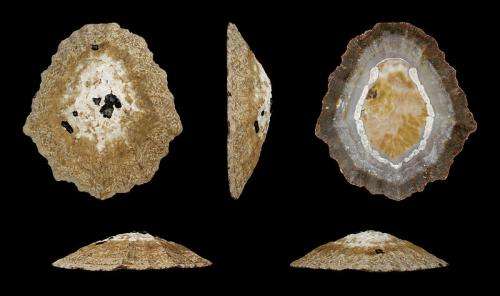June 18, 2013 report
Shellfish show population growth did not send humans out of Africa

(Phys.org) —Artifacts from the Middle Stone Age, which lasted from about 200,000 to 50,000 years ago, provide us with the earliest glimpses of modern human art and culture. Previously, scientists thought an increase in population drove the behavioral innovations that led to the creation of these artifacts and eventually, the expansion out of Africa. However, by examining mollusk shells from Stone Age sites, Richard Klein of Stanford University and Teresa Steele of University of California, Davis, have determined that a significant population increase did not occur until the Late Stone Age, after the migration out of Africa had already begun. Their research appears in the Proceedings of the National Academy of Sciences.
Archeologists have found precursors of modern human artwork and jewelry, including fragments of ochre with abstract incisions and shells with perforations, in Middle Stone Age sites. The humans who made them, between 85,000 and 65,000 years ago, must have had modern cognitive abilities and exhibited modern behaviors. During the Late Stone Age, these abilities and behaviors allowed humans to create objects that are recognizable as art and spurred the migration to Eurasia.
Population growth has been a popular explanation for the innovations of the Middle Stone Age. As population increases, the chance that someone will come up with an innovative idea also increases. At the same time, the probability that an idea will be lost decreases.
To test the hypothesis that a large increase in population drove Middle Stone Age innovation, Klein and Steele measured the shells of slow-growing mollusks found in Middle and Late Stone Age middens on the southern and western coasts of South Africa. They reasoned that selection pressure, caused by an increase in human population, would decrease median shell size. Frequent foraging by large numbers of humans would have prevented many shellfish from reaching their full size.
The researchers found that the median size of Middle Stone Age shells was larger than that of Late Stone Age shells. This showed that selection pressure, and therefore human population, was greater in the Late Stone Age than the Middle Stone Age. In addition, shellfish from smaller species were more common in Late Stone Age than new Stone Age sites. As selection pressure increased with population size, humans would be less likely to overlook smaller shellfish as a source of food.
Klein and Steele claim that because the population increase did not occur until after the migration out of Africa, which took place between 60,000 and 50,000 years ago, had already begun, there must be another explanation for the cultural advancements of the Middle Stone Age. This could be a change in the human genome or pressure causd by climate change.
More information: Archaeological shellfish size and later human evolution in Africa, PNAS, Published online before print June 17, 2013, doi: 10.1073/pnas.1304750110
Abstract
Approximately 50 ka, one or more subgroups of modern humans expanded from Africa to populate the rest of the world. Significant behavioral change accompanied this expansion, and archaeologists commonly seek its roots in the African Middle Stone Age (MSA; ∼200 to ∼50 ka). Easily recognizable art objects and "jewelry" become common only in sites that postdate the MSA in Africa and Eurasia, but some MSA sites contain possible precursors, especially including abstractly incised fragments of ocher and perforated shells interpreted as beads. These proposed art objects have convinced most specialists that MSA people were behaviorally (cognitively) modern, and many argue that population growth explains the appearance of art in the MSA and its post-MSA florescence. The average size of rocky intertidal gastropod species in MSA and later coastal middens allows a test of this idea, because smaller size implies more intense collection, and more intense collection is most readily attributed to growth in the number of human collectors. Here we demonstrate that economically important Cape turban shells and limpets from MSA layers along the south and west coasts of South Africa are consistently and significantly larger than turban shells and limpets in succeeding Later Stone Age (LSA) layers that formed under equivalent environmental conditions. We conclude that whatever cognitive capacity precocious MSA artifacts imply, it was not associated with human population growth. MSA populations remained consistently small by LSA standards, and a substantial increase in population size is obvious only near the MSA/LSA transition, when it is dramatically reflected in the Out-of-Africa expansion.
Journal information: Proceedings of the National Academy of Sciences
© 2013 Phys.org




















